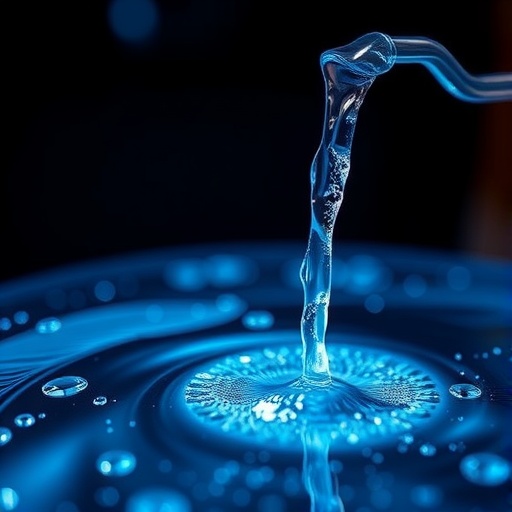A novel breakthrough in the monitoring and evaluation of water quality has emerged from the realm of nanotechnology, as outlined in a recent study by researcher A. Boualem. The work proposes an innovative solution for detecting and measuring the concentrations of pollutants in water bodies. This advancement may revolutionize how environmental scientists and policymakers address water pollution, a critical issue affecting ecosystems and human health globally. The new methodology stems from a deep understanding of nanomaterials and their interaction with various contaminants, setting the stage for more effective water quality diagnostics.
At the heart of this research lies the design and application of nanosensors capable of providing real-time data on water pollution levels. Traditional methods of monitoring water quality often rely on time-consuming laboratory analyses, which can delay responses to contamination events. Boualem’s approach leverages the unique characteristics of nanomaterials to create sensors that can detect minute quantities of pollutants almost instantaneously. This rapid detection capability is crucial in cases where timely interventions can prevent broader ecological damage or protect human health from waterborne diseases.
These nanosensors operate through a sophisticated mechanism that enhances their ability to identify specific pollutants, including heavy metals, organic compounds, and pathogens. By integrating advanced nanotechnology with biological sensing techniques, Boualem’s design enables the detection of multiple types of pollutants simultaneously. For instance, the sensors can be coated with biomolecules that selectively bind to target contaminants, triggering a measurable change in the sensor’s output signal. This specificity enhances the reliability of the measurements and ensures that response systems can be accurately calibrated to address pollution sources.
The materials used in constructing these sensors are critical to their performance. Boualem’s research emphasizes the selection of nanomaterials that exhibit high surface area-to-volume ratios, leading to improved interaction with potential contaminants. Nanoparticles such as carbon nanotubes, quantum dots, and metal-organic frameworks are among the promising candidates explored in the study. Their unique properties not only facilitate enhanced sensitivity but also contribute to lower detection limits, allowing for the identification of pollutants at concentrations that would be challenging to detect with conventional approaches.
Another significant aspect of Boualem’s research is the integration of these nanosensors into portable and user-friendly devices. The feasibility of deploying these technologies in remote or resource-limited settings provides a new avenue for communities to monitor their water quality independently. By simplifying the process of pollution detection, local authorities and citizens can take proactive measures to protect their water resources without waiting for external agencies to conduct analyses. This empowerment could lead to increased public awareness and involvement in environmental protection efforts.
Moreover, the potential applications of Boualem’s nanosensor technology extend beyond domestic water supply monitoring. Industries relying heavily on water usage, such as agriculture and manufacturing, can utilize these sensors for real-time monitoring of wastewater treatment processes. This adaptability highlights the technology’s versatility and its collective impact across various sectors, from public health initiatives to environmental sustainability practices.
As water pollution continues to pose a significant threat to global ecosystems, Boualem’s findings are timely and necessary. The research offers a glimpse into how nanotechnology can address pressing environmental concerns by creating efficient, cost-effective solutions for monitoring pollutants. With the increasing occurrence of extreme weather events and industrial activities, the demand for such technologies is more critical than ever, as they can help mitigate the adverse effects of pollution on the environment.
In conducting his research, Boualem has also considered the environmental impact of the nanomaterials and the resulting sensors. Ensuring that these technologies are eco-friendly and do not contribute to additional pollution is paramount. The study explores potential routes for the sustainable production of nanomaterials and emphasizes the importance of a cradle-to-cradle lifecycle approach in material development. Thus, Boualem advocates for the establishment of comprehensive regulations surrounding the usage and disposal of nanotechnology to safeguard future generations.
While this research holds immense promise, Boualem acknowledges the need for collaboration among scientists, industries, and policymakers to drive the widespread adoption of these technologies. Establishing standardized testing protocols and regulatory frameworks will be essential for validation and public acceptance. Additionally, further research into the long-term effects of nanomaterials in natural environments will be key to ensuring ecological safety as these innovative solutions roll out.
Ultimately, Boualem’s research underscores a critical shift towards leveraging cutting-edge science to address age-old problems associated with water pollution. By harnessing the power of nanotechnology, this work not only advances scientific knowledge but also lays the groundwork for real-world applications that can have profound impacts on global health and environmental protection. As the community continues to grapple with the challenges posed by polluted water sources, integrating these high-tech solutions could pave the way for cleaner, safer water in the future.
In conclusion, the work spearheaded by Boualem represents an important step forward in the fight against water pollution. The integration of nanotechnology into water monitoring systems offers new hope for effective pollution management and mitigation strategies. Through innovative research and responsible technology development, the possibility of cleaner water sources is on the horizon, fostering a healthier planet for all living beings. Boualem’s findings serve as a clarion call for the scientific community and society at large to embrace technological progress in protecting one of our most precious resources – water.
Subject of Research: Water pollution detection using nanotechnology.
Article Title: A new nanotechnology-based solution for monitoring, detecting, and measuring water pollution concentrations.
Article References:
Boualem, A. A new nanotechnology-based solution for monitoring, detecting, and measuring water pollution concentrations.
Environ Sci Pollut Res (2025). https://doi.org/10.1007/s11356-025-37049-0
Image Credits: AI Generated
DOI:
Keywords: Nanotechnology, water pollution, sensors, environmental monitoring, sustainable technology.




